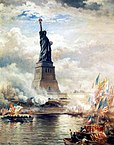
The quarter, short for quarter dollar, is a United States coin worth 25 cents, one-fourth of a dollar. It has a diameter of .955 inch (24.26 mm) and a thickness of .069 inch (1.75 mm). The coin sports the profile of George Washington on its obverse, and its reverse design has changed frequently. It has been produced on and off since 1796 and consistently since 1831.

The United States Mint has minted numerous commemorative coins to commemorate persons, places, events, and institutions since 1848. Many of these coins are not intended for general circulation, but are still legal tender. The mint also produces commemorative medals, which are similar to coins but do not have a face value, and therefore are not legal tender.

The American Silver Eagle is the official silver bullion coin of the United States.

The American Gold Eagle is an official gold bullion coin of the United States. Authorized under the Gold Bullion Coin Act of 1985, it was first released by the United States Mint in 1986. Because the term "eagle" also is the official United States designation for pre-1933 ten dollars gold coins, the weight of the bullion coin is typically used when describing American Gold Eagles to avoid confusion. This is particularly true with the 1/4-oz American Gold Eagle, which has a marked face value of ten dollars.
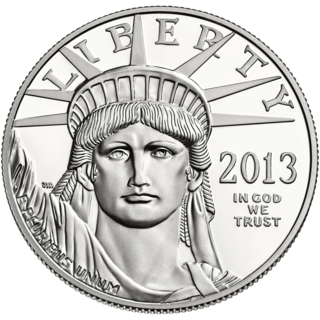
The American Platinum Eagle is the official platinum bullion coin of the United States. In 1995, Director of the United States Mint Philip N. Diehl, American Numismatic Association President David L. Ganz, and Platinum Guild International Executive Director Jacques Luben began the legislative process of creating the Platinum Eagle. After over two years of work, the 99.95% fine platinum coins were released by the United States Mint in 1⁄10, 1⁄4, 1⁄2 and 1 troy oz denominations. In late 2008, the fractional denominations were discontinued, leaving only the one ounce denomination. The Platinum Eagle is authorized by the United States Congress, and is backed by the United States Mint for weight, content, and purity.
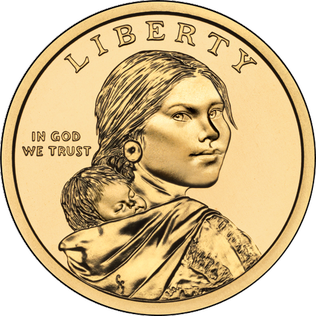
The Sacagawea dollar is a United States dollar coin first minted in 2000, although not released for general circulation from 2002 to 2008 and again from 2012 onward due to its general unpopularity with the public and low business demand for the coin. These coins have a copper core clad by manganese brass, giving them a distinctive golden color. The coin features an obverse by Glenna Goodacre. From 2000 to 2008, the reverse featured an eagle design by Thomas D. Rogers. Since 2009, the reverse of the Sacagawea dollar has been changed yearly, with each design in the series depicting a different aspect of Native American cultures.
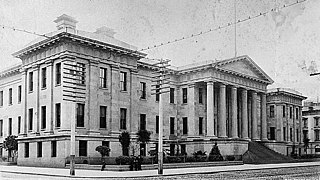
The San Francisco Mint is a branch of the United States Mint and was opened in 1854 to serve the gold mines of the California Gold Rush. It quickly outgrew its first building and moved into a new one in 1874. This building, the Old United States Mint, also known affectionately as The Granite Lady, is one of the few that survived the great 1906 San Francisco earthquake. It served until 1937, when the present facility was opened.

The West Point Mint Facility is a U.S. Mint production and depository facility erected in 1937 near the U.S. Military Academy in West Point, New York, United States. Originally it was called the West Point Bullion Depository. At one point it had the highest concentration of silver of any U.S. mint facility, and for 12 years produced circulating pennies. It has since minted mostly commemorative coins and stored gold.
The Artistic Infusion Program (AIP) is a program of the United States Mint, established in 2003, which invites American artists to create designs for U.S. coins and medals, most notably the State Quarters series of coins. The goal of the AIP is to enrich and diversify the design of United States coins and medals by contracting a collection of artists with varying artistic skills and talents.

The Library of Congress bimetallic eagle is a modern U.S. commemorative coin issued in the ten dollar denomination. It is the first gold and platinum bimetallic coin to be issued by the United States Mint. It was issued in proof and business strike qualities.

The American Buffalo, also known as a gold buffalo, is a 24-karat bullion coin first offered for sale by the United States Mint on June 22, 2006, and available for shipment beginning on July 13. The coin follows the design of the Indian Head nickel and has gained its nickname from the American Bison on the reverse side of the design. This was the first time ever that the United States Government has minted pure (.9999) 24-karat gold coins for the public. The coin has a legal tender (face) value of US$50. Due to a combination of the coin's popularity and the tremendous increase in the price of gold since its creation the coin's value has increased considerably in a short time of just a few years. The initial 2006 U.S. Mint price of the proof coin was $800. In 2007 the Mint proof coin was $899.95, $1,410.00 in 2009, and $2,010.00 in 2011.

In 2007, the United States Mint released a gold five-dollar commemorative coin which commemorates the 400th year after the founding of Jamestown. Surcharges from the sale of the Jamestown commemorative were donated to Jamestown-Yorktown Foundation of the Commonwealth of Virginia, the Secretary of the Interior and the Association for the Preservation of Virginia Antiquities to support programs that promote the understanding of the legacies of Jamestown.
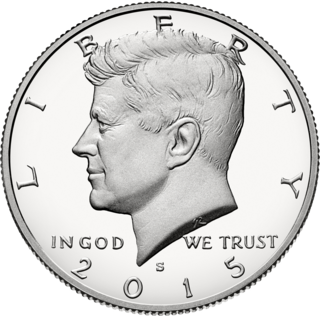
The Kennedy half dollar is a United States coin that has been minted since 1964. In the first year of production the coins were minted in 90% silver and 10% copper. From 1965 through 1970, the coins were minted in a clad composition of mostly silver outer layers and a mostly copper inner layer. After 1970, the coins are minted in a copper–nickel clad composition. From 1992 to 2018, 90% silver coins were made for inclusion in special "Limited Edition" silver proof sets. Beginning 2019 coins in the special silver proof sets are produced from pure (.9999) silver.
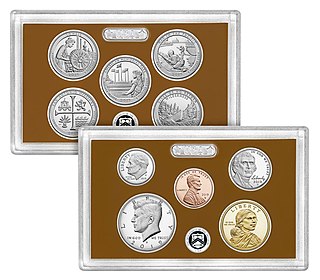
The United States Mint Proof Set, commonly known as the Proof Set in the United States, is a set of proof coins sold by the United States Mint. The proof set is popular with coin collectors as it is an affordable way to collect examples of United States coinage in proof condition.
The Leif Ericson Millennium commemorative coins are a series of coins issued by the United States Mint to commemorate the 1,000th anniversary of Leif Ericson's discovery of the Americas.

The Korean War Memorial silver dollar is a commemorative silver dollar issued by the United States Mint in 1991. The coin commemorated the 38th anniversary of the end of the Korean War.
The First in Flight Centennial commemorative coins are a series of commemorative coins issued by the United States Mint in 2003. The coins, issued in half dollar, dollar, and eagle ($10) denominations, commemorate the 100th anniversary of the first controlled flight of a powered heavier-than-air aircraft. The coins were authorized by Public Law 105-124.
























